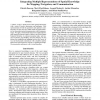Free Online Productivity Tools
i2Speak
i2Symbol
i2OCR
iTex2Img
iWeb2Print
iWeb2Shot
i2Type
iPdf2Split
iPdf2Merge
i2Bopomofo
i2Arabic
i2Style
i2Image
i2PDF
iLatex2Rtf
Sci2ools
ICIA
2007
2007
Integrating Multiple Representations of Spatial Knowledge for Mapping, Navigation, and Communication
A robotic chauffeur should reason about spatial information with a variety of scales, dimensions, and ontologies. Rich representations of both the quantitative and qualitative characteristics of space not only enable robust navigation behavior, but also permit natural communication with a human passenger. We apply a hierarchical framework of spatial knowledge inspired by human cognitive abilities, the Hybrid Spatial Semantic Hierarchy, to common navigation tasks: safe motion, localization, map-building, and route planning. We also discuss the straightforward mapping between the variety of ways in which people communicate with a chauffeur and the framework’s heterogeneous concepts of spatial knowledge. We present pilot experiments with a virtual chauffeur.
| Added | 02 Oct 2010 |
| Updated | 02 Oct 2010 |
| Type | Conference |
| Year | 2007 |
| Where | ICIA |
| Authors | Patrick Beeson, Matt MacMahon, Joseph Modayil, Aniket Murarka, Benjamin Kuipers, Brian Stankiewicz |
Comments (0)

